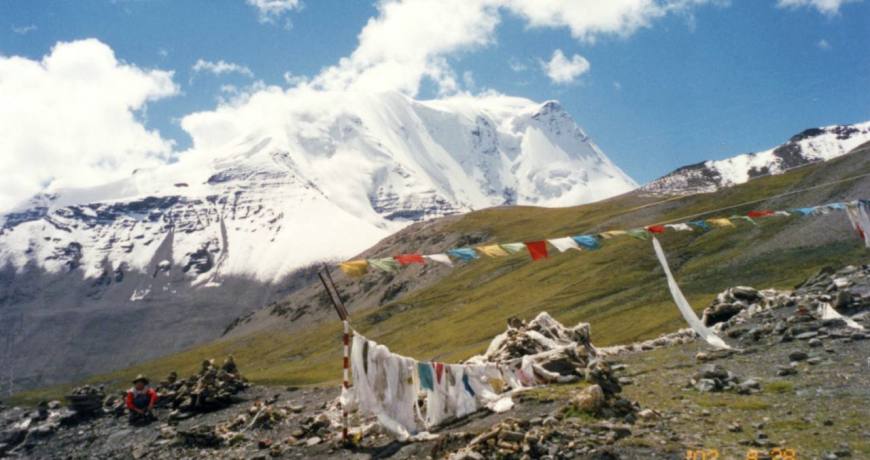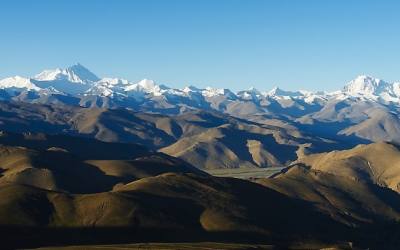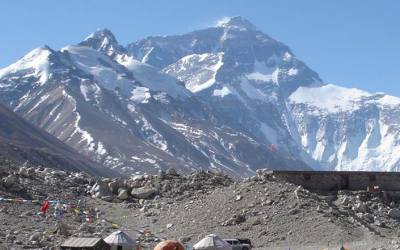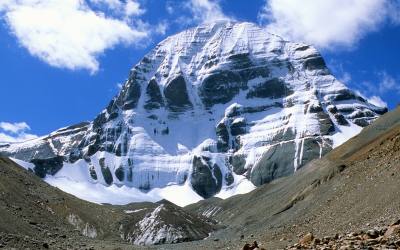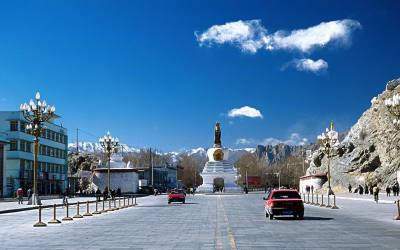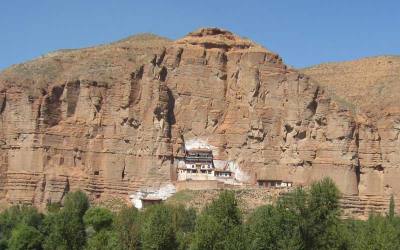For thousands of years, Tibet lay under the ancient Sea of Tethys. Eighty million years ago, India crashed into Asia, pushing up the Himalayas, lifting the ocean bottom above water, and creating this magical land. Mystical land, Shangrila, Forbidden Country: Tibet has many names and inspires an air of mystical dreams. However, Tibet is real and a beautiful place to travel. It possesses a unique culture, firmly rooted in Tibetan religion, but with strong influence from the geography of the Himalayas, and the neighbouring civilisations of India and China.
Geographically, Tibet can be divided into three major parts - north, south and east. The eastern part is forest region, occupying approximately one-fourth of the land. Virgin forests run the entire breadth and length of this part of Tibet. The northern part is open grassland, where nomads and yak and sheep dwell here. This part occupies approximately half of Tibet. The southern and central part is agricultural region, occupying about one-fourth of Tibet’s land area. All major Tibetan cities and towns such as Lhasa, Shigatse, Gyantse and Tsetang are located in this area and is considered the cultural center of Tibet.
Day 01: Arrival and Transfer to Hotel in Kathamdnu
Day 02: Free day in Kathmandu or self sight seeing tour
Day 03: Kathmandu to Lhasa by air
Day 04: Lhasha
Day 05: Lhasa
Day 06: Gyantse
Day 07: Shigatse
Day 08: Shigatse
Day09: Shegar
Day10:Zhangmu
Day11: Kathmandu
Day12: Free day at Kathmandu or self sight seeing tour
Day13: Tour Ends ( Departure onwards)
Day 1 –Arrival at Kathmandu and Transfer to Hotel in Kathmandu
Upon arrival in Kathmandu. Our airport representative will be waiting outside the airport terminal a few metres from the exit door. Please check your name at play card. He will bring you to hotel in kathmandu. The drive from the airport to the hotel is around 20 minutes.
Day 2 –Free day at Kathmandu or self sight seeing tour ( option are)
Hanumandhoka ( Kathamdnu Durbar Square ):
It is the historic seat of royalty. The Durbar Square , with its old temples and palaces, epitomizes the religious and cultural life of people. It is here that kings of Nepal are crowned and their coronations solemnized. Interesting things to see here are, Taleju temple built by king Mahendra Malla in 1954 AD, the temple of Kal Bhairab , the god of destruction, Nautale durbar, the statue of King Pratap Malla, the big drum and the Jaganath temple. It was listed in the UNESCO world heritage monument list in 1979.
On the right hand corner, a large wooden lattice screen hides an enormous gilded face of Sweta Bhairab. The screen is removed only during the Indra Jatra festival.. there are also the Numismatic museum and Tribhuban museum inside the Hanuman Dhoka palace building . Photography is prohibited inside the museums. Both the mseums remain closed on Tuesday and government holidays.
Swoyambhunath ( Monkey temple)
This is one of the world’s most glorious Buddhist Chaityas. It is said to be 2,000 years old. Painted on the four sides of the spire’s base are the all seeing eyes of Lord Budhha. It is 3Km west of Kathmandu city and it situated on a hillock about 77 m commands an excellent view of the Valley. This stupa is the oldest of its kind in Nepal . It was listed in the UNSCO world Heritage Monument List in 1979.
Day 3-5 - Lhasa
We are transferred from the hotel to Kathmandu’s Tribhuvan Airport for the flight to Lhasa. This is one of the most spectacular flights in the world as we follow the high mountain peaks before crossing over the Himalayan chain to the high Tibetan Plateau. After arriving at Gongkar Airport, there is a long drive to the fabled city of Lhasa. The distance used to be 90 kilometres, but has been slightly shortened due to a tunnel that was recently opened. We spend the rest of our first day in Lhasarelaxing to aid our acclimatization, as it is likely we will be feeling some effects after coming from Kathmandu. On Days 4 and 5 we explore this once isolated city which is now a mixture of old and new. We visit the fabled Potala Palace, with optional sightseeing (entrances paid locally) to JokhangTemple plus Sera and Drepung Monasteries. There is free time to wander around and explore this fascinating city on our own. You can wander around the markets around the Barkhor or arrange a taxi to go out to the Norbulingka (Summer Palace) or the interesting Tibet Museum.
Day 6 - Gyantse
We follow the Friendship Highway - a spectacular road which traverses high mountain passes and crosses wide plateaus, connecting Lhasa with Kathmandu. Please note that the road conditions are very poor in many places in Tibet, so we should be prepared for bumpy and sometimes slow journeys. We first travel through Tibet’s richest farming areas, before crossing the Brahmaputra River as it winds its way down towards the Bay of Bengal many hundreds of kilometres away. In Tibet it flows at an altitude of 3939 metres above sea level, making it is the highest major river in the world. We cross the river on a solid suspension bridge and wind our way to Kamba La, where we enjoy a view over the huge Yamdrok Tso (Scorpion Lake). After the lake we climb again, this time to the Karo La (5010 metres) before descending to the historic town of Gyantse, which served as the capital of a small kingdom in the 15th century. The beautiful Kumbum Chorten, built around 1400, and the huge ruined fort bear witness to the powers that once ruled here. It later became the main centre for trade with British India and was the focal point for Younghusband’s British Expedition to Tibet in 1904, when his soldiers defeated some 5000 Tibetans and destroyed the fort by cannon fire. Gyantse is a great place to try the local specialty of ’momo’, which are small meat dumplings.
Day 7-8 - Shigatse
In the morning we explore Gyantse before taking a three-hour drive across the Tibetan Plateau in the afternoon. Our destination is Shigatse(3900m), the second largest city in Tibet with a population of some 40,000 people. Tashilhunpo Monastery is the traditional seat of the Panchen Lama, the most important incarnation for Tibetan Buddhists after the Dalai Lama. This impressive religious centre contains a giant statue of Buddha in the Temple of Maitreya as well as an ornate tomb, which is the final resting-place of the fourth Panchen Lama. Its huge size ensures it is almost a town in itself. One of Tibet’s most active monasteries, it is currently being restored to its former beauty. We have a free time in Shigatse on Day 8, when we can just wander by ourselves through the old town or visit the market place and try one of the many unusual delicacies on offer.
Day 9 - Shegar
Our adventure continues with a drive over rough, dusty roads to Shegar. In the morning we cross JaiTsuo Pass with stunning views of the Himalayan peaks to the south. Although the scenery is desolate, the country is dotted with busy villages and ruined monasteries. Amongst these villages is the major town of Lhaze which makes for a convenient halfway point to stop; here we have the opportunity to try a local-style lunch. Our night stop, Shegar, is a small village of 1500 inhabitants with an interesting fort.
Day 10 - Zhangmu
We pass through the Shegar checkpoint and then cross the Tingri Plains before ascending to Lalung Leh (5050m). At this pass we have spectacular views to the east (weather permitting) of Everest (8850m), Lhotse (8516m), Makalu (8463m), Cho Oyu (8201m) and Gauri Shanker (7146m). To the west it may be possible to see Xixapangma (8013m), Langtang (7245m) and Dorje Lakpa (6980m). That’s five peaks, each over 8000 metres in height - a truly spectacular sight. From the pass, we descend steeply over 3000 metres to the small town of Nyalam. As you near the border, the road is cut into the cliffs high above the valley floor. If you don’t like heights, you should sit on the left-hand side of the vehicle!
Day 11 - Kathmandu
After breakfast we make the short trip to the border and complete customs and immigration formalities. We cross the Friendship Bridge that spans the Bhote (Tibet) Kosi River and enter Nepal, before driving back to Kathmandu. Our journey here is in complete contrast to the wild and often barren plains of Tibet. We travel through heavily populated areas, with lush terraced hillsides rising steeply from the valley. After nearly five hours of travelling we arrive back at our hotel in Kathmandu, where we spend our final night.
Day 12 –Free day at Kathmandu or self sight seeing tour ( option are)
Boudhanath stupa
Boudhanath Stupa (or Bodnath Stupa) is the largest stupa in Nepal and the holiest Tibetan Buddhist temple outside Tibet . It is the center of Tibetan culture in Kathmandu and rich in Buddhist symbolism. The stupa is located in the town of Boudha , on the eastern outskirts of Kathmandu .
History
Bodnath was probably built in the 14th century after the Mughal invasions; various interesting legends are told regarding the reasons for its construction. After the arrival of thousands of Tibetans following the 1959 Chinese invasion, the temple has become one of the most important centers of Tibetan Buddhism. Today it remains an important place of pilgrimage and meditation for Tibetan Buddhists and local Nepalis, as well as a popular tourist site.
Pashupatinath Temple :
Situated 5km east of kathamandu, the temple of Lord Shiva , Pashupatinath, with two tired golden roof and silver door is considered one of the holiest for Hindus. Although only Hindus are allowed inside the temple, visitors can clearly see the temple and the activites performed in the Templepremises from the eastern bank of the Bagmati river. The Temple was listed in the UNESCO world heritage Monument List in 1979
Bhaktapur durbar Squares:
The Golden Gate is the entrance to the main courtyard of the Palace of 55 Windows, built by King Ranjit Malla. The gate is one of the most beautiful and richly carved specimens of its kind in the entire world. This gate is embellished with deities and monsters with marvelous intricacy. The palace of 55 Window was built in 1700 AD. Among the brick walls in their gracious setting and sculptural design, is a balcony of 55 windws. This balcony is a masterpiece of wood carving. The stone temple of Batsala Devi which is also
located in the Durbar Square is full of intricate carvings. This temple also sets a beautiful example of Shikhara style architecture in Nepal . There is a bronze bell on the terrace of the temple which is also known as the Bell of Barking Dogs. This colossal bell, placed in 1737 AD, used to ring to signal curfew those days. The main square of the city contains innumerable temples and other architectural showpieces like the Lion Gate, the statue of King Bhupatindra Malla, the Picture Galley, the BatsalTemple , etc. A magnificent statue of King Bhupatindra Malla in the act of worship is placed on the column facing
the palace. It was listed in the UNESCO World Heritage Monument list in 1979.
Patan
The ancient city of Patan , lying 5 km southwest of kathmandu, is known as the city of fine arts, The city is full of Hindu temples and Buddhist monuments. The diversity of the medieval culture that allowed both Hinduism and Buddhism to flourish has left a rich legacy of impressive sightseeing in this city for today’s visitors.
Patan Durbar Square:
Situated in the heart of the city, constitutes the focus of visitor’s attraction. The square is full of ancient palaces, Temple and shrines, noted for their exquisite carvings. The Patan durbar Square consist of three main chowks or countryards, the Central Mul Chowk, Sundari Chowk and Keshar narayan Chowk, The Sundari Chowk holds in its center a masterpiece of stone architecture. The Royal Bath called Tushahity. It was listed in the UNESCO world Heritage Monument list in 1979.
Krishna Mandir:
Built in 1637 AD, the temple of Lord Krishaa holds a commanding position in the palace complex of Patan. It is supposed to be the first specimen of Shikhara style architecture in Nepal . It is the only temple in Nepal having 21 spires and is completely 21 spires and is completely mad of stone.
Day 13: Tour Ends ( Departure onwards)
Price per person US$ 900.00 for the tour to Tibet at Budget class hotel
Tibet travel permit will cost US$ 85.00 per person
Kathmandu to Lhasa flight will cost US$ 530 per person
Hotel in kathmandu will cost US$ 30.00 per night for double room with bed and breakfast
Hotel we use in kathmandu
Kathmandu Prince Hotel
Thamel, Chhetrapati, kathmandu, Nepal Tel : 4255961, 4255282, Fax : 977-1-4255282
E-Mail : [email protected], Website : www.kathmanduprincehotel.com
Or
Potala Guest House
Thamel, chetrapati, Kathmandu, Tel : 4226566, 4220467
Email: [email protected], Website : www.potalaguesthouse.com
What’s Included
- Airport pick up and drop by private transport
- 4 night hotel in kathmandu at tourist standard hotel with Bed and Breakfast ( Centrally located, attach bathroom, hot and cold shower)
- Kathmandu to Lhasa by air
- Tibetan English speaking guide
- Tibet travel permit
- Transportation in lhasa by private land crusher with Driver
- Accommodation on twin sharing basis with breakfast at budget class hotel
- All the entrance fees for monastery as per itinerary at Tibet
What’s not Included
- Sight seeing tour in kathmandu valley and all the entrance fees
- Lunch & dinner
- Personal expenses like tips drinks etc
- Reentry visa fee for Nepal
